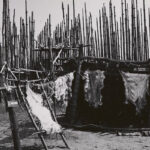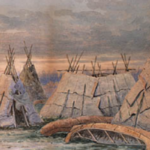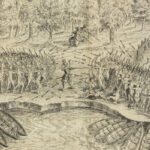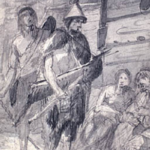Miawpukek First Nation: Resilience on the Southern Coast
The Miawpukek First Nation, located in Conne River, Newfoundland and Labrador, represents a significant chapter in the history of the Mi’kmaq Nation. The story of Miawpukek is one of adaptability, cultural preservation, and resilience. Situated on the island’s rugged southern coast, Miawpukek reflects the deep connection between the Mi’kmaq people and their environment. From pre-history and early settlement patterns to the arrival of European explorers and the subsequent transformation of their traditional way of life, the Miawpukek First Nation has navigated the currents of change while maintaining its identity and cultural heritage.
Pre-History: Mi’kmaq Origins and Arrival in Newfoundland
The Mi’kmaq, ancestors of the Miawpukek First Nation, are part of the Algonquian language family and have lived in Mi’kma’ki, their traditional homeland, for over 10,000 years. This expansive territory includes present-day Atlantic Canada and parts of the northeastern United States. The Mi’kmaq’s semi-nomadic lifestyle centred on a profound understanding of the natural world, as they moved seasonally between coastal and inland regions to harvest resources sustainably.
The Mi’kmaq’s presence in Newfoundland likely dates back several centuries before European contact. Oral traditions, bolstered by archaeological evidence such as stone tools and pottery, suggest that Mi’kmaq groups arrived on the island as they expanded their territory. Newfoundland, known to the Mi’kmaq as Ktaqamkuk, offered abundant resources, including fish, seals, and caribou. The island’s rivers, bays, and forests provided sustenance and supported spiritual practices.
The Conne River area, where Miawpukek is now located, became a focal point for settlement due to its proximity to rich fishing grounds and its strategic location along seasonal migratory routes for game animals. The Mi’kmaq worldview emphasized the interconnectedness of all living things, and the environment of southern Newfoundland reinforced their cultural and spiritual practices.
Governance and Social Structure
Traditional Mi’kmaq governance was based on consensus, respect, and collective decision-making. Each region of Mi’kma’ki, including Ktaqamkuk, was led by a Sagamore (chief) who worked in collaboration with elders and other community leaders. The Mi’kmaq Grand Council (Santé Mawiómi) united the districts, providing a framework for diplomacy, resource management, and spiritual guidance.
Kinship ties were vital to Mi’kmaq society, fostering cooperation and mutual support within the community. Oral traditions played a central role in preserving history, spiritual teachings, and practical knowledge. The stories of Glooscap, the cultural hero who taught the Mi’kmaq how to live in harmony with nature, provided moral lessons and reinforced the community’s values.
First Contact with European Explorers
The Mi’kmaq of Ktaqamkuk were among the first Indigenous peoples to encounter European explorers. Early interactions, beginning in the late 15th and early 16th centuries, were with Basque, Breton, and Portuguese fishermen who came to Newfoundland’s coasts for its abundant cod fisheries. These initial encounters were largely transactional, with the Mi’kmaq trading furs, fish, and other resources for European goods such as metal tools, beads, and cloth.
The establishment of permanent European settlements in Newfoundland during the 17th and 18th centuries introduced more sustained contact. French explorers and settlers, in particular, sought alliances with the Mi’kmaq, recognizing their knowledge of the land and waterways as invaluable for trade and survival. The fur trade became a cornerstone of Mi’kmaq-European relations, with the Mi’kmaq of Conne River participating in the exchange of beaver pelts and other goods.
While trade brought material benefits, it also disrupted traditional economies and introduced dependencies. Furthermore, European diseases such as smallpox and measles devastated Mi’kmaq communities, significantly reducing populations and creating social upheaval.
Relationships with Missionaries and Settlers
The arrival of French missionaries during the 17th century marked a new chapter in Mi’kmaq-European relations. The Mi’kmaq, including those of Ktaqamkuk, often adopted elements of Catholicism while integrating them with their traditional spiritual practices. This blending of beliefs allowed the Mi’kmaq to navigate the pressures of colonization while maintaining their cultural identity.
During the colonial conflicts of the 18th century, the Mi’kmaq of Newfoundland allied with the French against the British, motivated by shared interests in resisting British expansion. However, the British victory in 1763 and the subsequent colonization of Newfoundland led to increased pressures on Mi’kmaq lands and autonomy. The imposition of colonial policies and the influx of settlers disrupted traditional Mi’kmaq lifeways, forcing communities like Miawpukek to adapt.
The 19th and 20th Centuries: Challenges and Revitalization
The 19th century brought significant challenges to the Mi’kmaq of Conne River. The imposition of the Indian Act (1876) and the marginalization of Indigenous peoples in Newfoundland led to a decline in traditional practices. The Mi’kmaq were often excluded from economic and social opportunities, and their land rights were disregarded.
Despite these challenges, the Mi’kmaq of Conne River demonstrated remarkable resilience. Fishing remained central to their economy and culture, with the Conne River and nearby coastal waters continuing to provide sustenance. Traditional crafts such as basket-making and quillwork became both sources of income and expressions of cultural pride.
The residential school system, which sought to assimilate Indigenous children, caused profound trauma for many Mi’kmaq families. However, the elders of Miawpukek played a crucial role in preserving Mi’kmawi’simk, the Mi’kmaq language, and ensuring that cultural traditions were passed down to future generations.
In 1987, the Miawpukek First Nation achieved recognition under the Indian Act, marking a significant turning point. This recognition formalized their rights and provided a foundation for self-governance and community development.
Cultural Revitalization and Environmental Stewardship
In recent decades, Miawpukek has become a leader in cultural revitalization and environmental stewardship. Language immersion programs, cultural workshops, and the celebration of traditional practices have fostered a renewed sense of pride and unity within the community. The annual Powwow in Miawpukek is a vibrant celebration of Mi’kmaq culture, drawing participants from across Mi’kma’ki and beyond.
Environmental stewardship has also been a central focus for Miawpukek. Efforts to restore fish habitats, protect forests, and promote sustainable resource use reflect the Mi’kmaq’s enduring relationship with the land and waters. These initiatives are informed by traditional ecological knowledge, passed down through generations, and supported by modern conservation methods.
Miawpukek Today: A Thriving Community
Today, the Miawpukek First Nation is a thriving and self-sufficient community of over 800 members. Investments in education, healthcare, and infrastructure have transformed Miawpukek into a model of resilience and innovation. The community has successfully balanced the preservation of traditional practices with the embrace of modern opportunities, ensuring a bright future for generations to come.
Miawpukek’s success in economic development, including small businesses and cultural tourism, highlights its ingenuity and commitment to sustainability. The community’s achievements reflect the enduring spirit of the Mi’kmaq and their ability to adapt to a rapidly changing world.
Conclusion: A Legacy of Strength and Continuity
The history of the Miawpukek First Nation is a testament to the resilience, adaptability, and cultural richness of the Mi’kmaq people. From their ancient presence in Ktaqamkuk to their pivotal role in early European trade and their modern achievements in cultural revitalization and environmental stewardship, Miawpukek stands as a beacon of Mi’kmaq identity and strength.
As an elder from Miawpukek once said, “Our land, our stories, and our language are the roots of who we are. By protecting them, we honour our ancestors and build a future for our children.”
References
- Whitehead, Ruth Holmes. The Old Man Told Us: Excerpts from Micmac History, 1500–1950. Nimbus Publishing, 1991.
- Jesuit Relations. Documents of the Missions to New France. McGill University Press, 1962.
- Conrad, Margaret. A Concise History of Canada. Cambridge University Press, 2012.
- Miawpukek Heritage Centre. The Spirit of Conne River: A History of Miawpukek First Nation. Miawpukek Publications, 2020.
- Ridington, Robin. Trail to Heaven: Knowledge and Narrative in a Northern Native Community. Douglas & McIntyre, 1988.
- Environmental Justice Advocacy Group. Stewardship and Sovereignty: Indigenous Environmental Leadership in Canada. University of Guelph Press, 2019.
- Mi’kmaq Grand Council. Santé Mawiómi: Traditions and Governance of the Mi’kmaq Nation. Halifax Press, 1985.
- Johnston, Basil. Ojibway Heritage. McClelland & Stewart, 1976.
- Neeposh, Thomas. “Preserving the Spirit: The Vision of Miawpukek First Nation.” CBC News, 2021.
- Snow, Dean R. The Iroquois. Blackwell, 1994.



